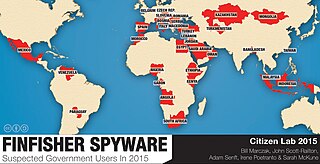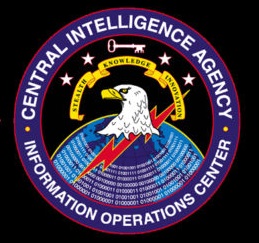Related Research Articles
Malware is any software intentionally designed to cause disruption to a computer, server, client, or computer network, leak private information, gain unauthorized access to information or systems, deprive access to information, or which unknowingly interferes with the user's computer security and privacy. Researchers tend to classify malware into one or more sub-types.
Spyware is any software with malicious behavior that aims to gather information about a person or organization and send it to another entity in a way that harms the user by violating their privacy, endangering their device's security, or other means. This behavior may be present in malware and in legitimate software. Websites may engage in spyware behaviors like web tracking. Hardware devices may also be affected.
Computer and network surveillance is the monitoring of computer activity and data stored locally on a computer or data being transferred over computer networks such as the Internet. This monitoring is often carried out covertly and may be completed by governments, corporations, criminal organizations, or individuals. It may or may not be legal and may or may not require authorization from a court or other independent government agencies. Computer and network surveillance programs are widespread today and almost all Internet traffic can be monitored.

This timeline of computer viruses and worms presents a chronological timeline of noteworthy computer viruses, computer worms, Trojan horses, similar malware, related research and events.

The Citizen Lab is an interdisciplinary laboratory based at the Munk School of Global Affairs at the University of Toronto, Canada. It was founded by Ronald Deibert in 2001. The laboratory studies information controls that impact the openness and security of the Internet and that pose threats to human rights. The organization uses a "mixed methods" approach which combines computer-generated interrogation, data mining, and analysis with intensive field research, qualitative social science, and legal and policy analysis methods. The organization has played a major role in providing technical support to journalists investigating the use of NSO Group's Pegasus spyware on journalists, politicians and human rights advocates.
In computing, the term remote desktop refers to a software- or operating system feature that allows a personal computer's desktop environment to be run remotely from one system, while being displayed on a separate client device. Remote desktop applications have varying features. Some allow attaching to an existing user's session and "remote controlling", either displaying the remote control session or blanking the screen. Taking over a desktop remotely is a form of remote administration.
Koobface is a network worm that attacks Microsoft Windows, Mac OS X, and Linux platforms. This worm originally targeted users of networking websites like Facebook, Skype, Yahoo Messenger, and email websites such as GMail, Yahoo Mail, and AOL Mail. It also targets other networking websites, such as MySpace, Twitter, and it can infect other devices on the same local network. Technical support scammers also fraudulently claim to their intended victims that they have a Koobface infection on their computer by using fake popups and using built-in Windows programs.
The Information Warfare Monitor (IWM) was an advanced research activity tracking the emergence of cyberspace as a strategic domain. Created in 2003, it closed in January 2012. It was a public-private venture between two Canadian institutions: The SecDev Group, an operational think tank based in Ottawa (Canada), and the Citizen Lab at the Munk School of Global Affairs, University of Toronto. The Principal Investigators and co-founders of the Information Warfare Monitor are Rafal Rohozinski and Ronald Deibert. The Information Warfare Monitor is part of the Citizen Lab’s network of advanced research projects, which include the OpenNet Initiative, the Fusion Methodology Centre, and PsiLab.
GhostNet is the name given by researchers at the Information Warfare Monitor to a large-scale cyber spying operation discovered in March 2009. The operation is likely associated with an advanced persistent threat, or a network actor that spies undetected. Its command and control infrastructure is based mainly in the People's Republic of China and GhostNet has infiltrated high-value political, economic and media locations in 103 countries. Computer systems belonging to embassies, foreign ministries and other government offices, and the Dalai Lama's Tibetan exile centers in India, London and New York City were compromised.
Cyber spying, cyber espionage, or cyber-collection is the act or practice of obtaining secrets and information without the permission and knowledge of the holder of the information using methods on the Internet, networks or individual computers through the use of proxy servers, cracking techniques and malicious software including Trojan horses and spyware. Cyber espionage can be used to target various actors- individuals, competitors, rivals, groups, governments, and others- in order to obtain personal, economic, political or military advantages. It may wholly be perpetrated online from computer desks of professionals on bases in far away countries or may involve infiltration at home by computer trained conventional spies and moles or in other cases may be the criminal handiwork of amateur malicious hackers and software programmers.
Zeus is a Trojan horse malware package that runs on versions of Microsoft Windows. It is often used to steal banking information by man-in-the-browser keystroke logging and form grabbing. Zeus is spread mainly through drive-by downloads and phishing schemes. First identified in July 2007 when it was used to steal information from the United States Department of Transportation, it became more widespread in March 2009. In June 2009 security company Prevx discovered that Zeus had compromised over 74,000 FTP accounts on websites of such companies as the Bank of America, NASA, Monster.com, ABC, Oracle, Play.com, Cisco, Amazon, and BusinessWeek. Similarly to Koobface, Zeus has also been used to trick victims of technical support scams into giving the scam artists money through pop-up messages that claim the user has a virus, when in reality they might have no viruses at all. The scammers may use programs such as Command prompt or Event viewer to make the user believe that their computer is infected.

FinFisher, also known as FinSpy, is surveillance software marketed by Lench IT Solutions plc, which markets the spyware through law enforcement channels.
Cyberweapons are commonly defined as malware agents employed for military, paramilitary, or intelligence objectives as part of a cyberattack. This includes computer viruses, trojans, spyware, and worms that can introduce malicious code into existing software, causing a computer to perform actions or processes unintended by its operator.
A cyberattack is any offensive maneuver that targets computer information systems, computer networks, infrastructures, personal computer devices, or smartphones. An attacker is a person or process that attempts to access data, functions, or other restricted areas of the system without authorization, potentially with malicious intent. Depending on the context, cyberattacks can be part of cyber warfare or cyberterrorism. A cyberattack can be employed by sovereign states, individuals, groups, societies or organizations and it may originate from an anonymous source. A product that facilitates a cyberattack is sometimes called a cyber weapon. Cyberattacks have increased over the last few years. A well-known example of a cyberattack is a distributed denial of service attack (DDoS).

The Office of Tailored Access Operations (TAO), now Computer Network Operations, and structured as S32, is a cyber-warfare intelligence-gathering unit of the National Security Agency (NSA). It has been active since at least 1998, possibly 1997, but was not named or structured as TAO until "the last days of 2000," according to General Michael Hayden.
Blackshades is a malicious trojan horse used by hackers to control infected computers remotely. The malware targets computers using operating systems based on Microsoft Windows. According to US officials, over 500,000 computer systems have been infected worldwide with the software.
The Shadow Network is a China-based computer espionage operation that stole classified documents and emails from the Indian government, the office of the Dalai Lama, and other high-level government networks. This incident is the second cyber espionage operation of this sort by China, discovered by researchers at the Information Warfare Monitor, following the discovery of GhostNet in March 2009. The Shadow Network report "Shadows in the Cloud: Investigating Cyber Espionage 2.0" was released on 6 April 2010, approximately one year after the publication of "Tracking GhostNet."
Regin is a sophisticated malware and hacking toolkit used by United States' National Security Agency (NSA) and its British counterpart, the Government Communications Headquarters (GCHQ). It was first publicly revealed by Kaspersky Lab, Symantec, and The Intercept in November 2014. The malware targets specific users of Microsoft Windows-based computers and has been linked to the US intelligence-gathering agency NSA and its British counterpart, the GCHQ. The Intercept provided samples of Regin for download, including malware discovered at a Belgian telecommunications provider, Belgacom. Kaspersky Lab says it first became aware of Regin in spring 2012, but some of the earliest samples date from 2003. Among computers infected worldwide by Regin, 28 percent were in Russia, 24 percent in Saudi Arabia, 9 percent each in Mexico and Ireland, and 5 percent in each of India, Afghanistan, Iran, Belgium, Austria, and Pakistan.
DarkComet is a remote access trojan (RAT) developed by Jean-Pierre Lesueur, an independent programmer and computer security coder from France. Although the RAT was developed back in 2008, it began to proliferate at the start of 2012. The program was discontinued, partially due to its use in the Syrian civil war to monitor activists but also due to its author's fear of being arrested for unnamed reasons. As of August 2018, the program's development "has ceased indefinitely", and downloads are no longer offered on its official website.

Vault 7 is a series of documents that WikiLeaks began to publish on 7 March 2017, detailing the activities and capabilities of the United States Central Intelligence Agency (CIA) to perform electronic surveillance and cyber warfare. The files, dating from 2013 to 2016, include details on the agency's software capabilities, such as the ability to compromise cars, smart TVs, web browsers including Google Chrome, Microsoft Edge, Mozilla Firefox, and Opera, the operating systems of most smartphones including Apple's iOS, and Google's Android, and computer operating systems including Microsoft Windows, macOS, and Linux. A CIA internal audit identified 91 malware tools out of more than 500 tools in use in 2016 being compromised by the release. The tools were developed by the Operations Support Branch of the C.I.A.
References
- ↑ 此软件无作者,无版权 (This software has no authors and no copyright). Gh0st RAT Beta 2.5 开源-红狼远控
- ↑ "Cyberspies' code a click away - Simple Google search quickly finds link to software for Ghost RAT program used to target governments". Toronto Star (Canada). Toronto, Ontario, Canada. March 31, 2009. Retrieved 2009-04-04.
- ↑ Markoff, John (March 28, 2009). "Vast Spy System Loots Computers in 103 Countries". New York Times . Retrieved March 29, 2009.
- ↑ Harvey, Mike (March 29, 2009). "Chinese hackers 'using ghost network to control embassy computers'". The Times . London. Retrieved March 29, 2009.
- Walton, Gregory (April 2008). "Year of the Gh0st RAT". World Association of Newspapers. Archived from the original on 2009-08-11. Retrieved 2009-04-01.